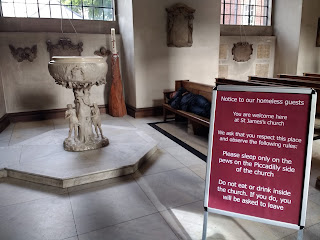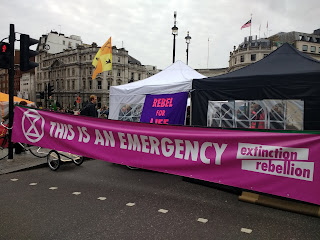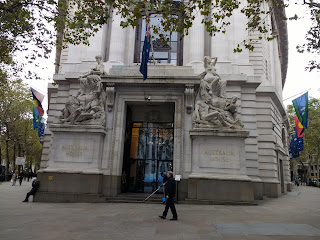The location of our short-term rental in London was in a great location, just a short walk from The Beatles' Abbey Road and also from the subway or 'tube' stop.
If you're a 'certain age' like we are, you'll remember Carnaby Street that was especially famous in the '60s as the shopping locale for funky items during the hippie era. Though there was little hint of that period evident in the stores lining the short street, it was still a lark walking down it!
From Regent Street, we returned to Trafalgar Square, one of the busiest spots in London and the location of the National Gallery we'd toured the previous day. All the streets around the square were closed off because of a huge Extinction Rebellion protest. I would likely have been ignorant of the worldwide global environmental group if not being educated by two of my brothers who were involved in its Ottawa chapter.
Somerset House was the last of the great riverside mansions that once stretched along the Strand. Now home to the Courtauld Gallery, the courtyard was a grand space to relax just five steps away from the hubbub of the Strand.
The visionary paintings of Veronica von Degenfeld were displayed in the church, an unusual 'gallery' in my opinion.
Beside the church was a statue of Queen Elizabeth I from 1586 that survived her reign. Symbolizing her religious and secular authority were the scepter and orb.
For the last day of our six-week trip to Ireland and the UK last fall, we decided to play tourist along Regent Street so we could mostly window shop along the street known for its most high-end shops. The wide boulevard was perfect for people like us who just wanted to gaze at the buildings' interesting architecture and store windows without having to worry about bumping into office workers and people busier than we were.
The large, arched-doorway building was the palace-like Apple store. I read that Londoners weren't used to the phenomenal customer service as that's uncommon in England!
Just off Regent Street was the venerable and stately Liberty Department Store that was established in 1875 and constructed from two decommissioned Royal Navy battleships.
My great-aunt Nina, after whom our first child was born, designed many of the fabrics for the store as she was a renowned artist. I admired the gorgeous silk scarves and would have loved to own one but the very hefty price tag was too rich for my blood.
Click on the photo to make it bigger so you can more closely look at Shakespeare's head peering out above the pub!
If you're a sock lover this Swedish store would have been the perfect place for you!
Knowing we'd soon be first-time grandparents, I made a beeline for Hamleys, Britain's biggest toy store that had its 250th anniversary a decade ago! Located in the heart of Regent Street, the seven-floor store had a staff of 200 employees, some dressed in fun costumes. Stuffed animal fans got to love both Paddington Bear and Build-a-Bear Workshops thanks to Hamleys.
More of swanky Regent Street:
From the relatively peaceful Regent Street, we were transported to the vibrant Picadilly Circus, a large square with Eros Fountain in the middle.
On massive billboards around the square were a series of ads enticing people to visit Saudi Arabia as the country had just opened up its borders to non-Muslims tourists for the first time. A couple of years previously, I had posted questions on that country's Trip Advisor forum about a possible visit only to learn it wasn't allowed. In the oddest of circumstances, later that day I received a response for the first time in about 18 months.
The eery timing plus the stunning images on the billboards was all it took to convince Steven and me to add a visit to Saudi Arabia this past spring. A trip to the desert kingdom was going to be part of our four-month-long trip to Asia and other countries we'd not yet toured in the Middle East but, of course, the pandemic put a stop to that.
From the sublime Regent Street and somewhat gaudy Picadilly Circus, we spent a few relaxing minutes to recoup in the tranquil St. Jame's Church designed by Christopher Wren. I liked how a sign welcomed homeless people to the church, even inviting them to sleep on the pews as long as food and drink weren't consumed.
Further down Picadilly Street was the "understated old school elegance" of the Fortnum & Mason department store that first opened its doors 300 years ago. The founders were footmen to Queen Anne. About 50 years ago, I first visited the store which has long been famous for its food court and signature teas. Of course, I had to buy some tea and other goodies this visit but for our second daughter and husband, not for us. I couldn't resist choosing the esoteric gin and tonic tea for them but don't know whether it pleased their taste buds.
To escape London's often dreary weather, Burlington Arcade and Picadilly Arcade were fun places to while away some time and part with hard-earned money.
From the arcades, it was an easy stroll past the elegant Bates Hats that have sold hats for 'only' more than a century (!) and then glance in at Turnbull & Asser who had sold custom-made or 'bespoke' men's apparel to Winston Churchill, Prince Charles, and James Bond. Seeing the legendary stores I'd read about in books for decades was a real treat.
It was only fitting that there was a statue nearby of Beau Brummel (1778-1840) as he was the figure who popularized the jacket, pants, and tie ensemble that men still wear to this day. The quote on his statue said, "To be truly elegant, one should not be noticed."
Impressive statues of Florence Nightingale and other figures took center stage in Pall Mall, a street named after a ball game played in the 17th century.
From Regent Street, we returned to Trafalgar Square, one of the busiest spots in London and the location of the National Gallery we'd toured the previous day. All the streets around the square were closed off because of a huge Extinction Rebellion protest. I would likely have been ignorant of the worldwide global environmental group if not being educated by two of my brothers who were involved in its Ottawa chapter.
We'd come to this area to begin our walk of Historic London, i.e. the area known as Westminster and then, a little further on, The City and the financial heart of London. This one-square-mile area had been a walled town called Londinium in Roman times and, in Shakespeare's period, was all that comprised London. We began walking along the Strand that used to be a high-end riverside promenade before retaining walls were built by the River Thames in the 19th century. If you've read of Charing Cross Station, here it is! The elegant train station design was considered standard in the early days of traveling by train.
In front of the station was the Charing Cross monument that subsequently lent its name to the station. The monument honored Queen Eleanor who died in 1290 as this was the last stop her funeral procession made on the long journey from Nottingham to Westminster Abbey. A memorial Eleanor Cross was built by her widower, King Edward I, at each overnight stop.
We took a quick detour onto Waterloo Bridge for some great river views.
Somerset House was the last of the great riverside mansions that once stretched along the Strand. Now home to the Courtauld Gallery, the courtyard was a grand space to relax just five steps away from the hubbub of the Strand.
Imagine ice skating here in the courtyard in the middle of winter! As it was the wrong season for that, I was happy feeding pigeons there, something I don't think I'd done for more than half a century since being in Trafalgar Square when visiting my English grandparents from Canada!
In the middle of the Strand, built before the road was widened to accommodate increased traffic, was St. Mary-le-Strand Church. Charles Dickens' parents married in the pretty interior that was lit by blue-and-green-stained glass.
The statue in the middle of the street honored Queen Victoria's longest-serving prime minister, William Gladstone.
Also in the middle of the street a block or so further on was St. Clement Danes Church that was also built by Wren in 1682 and was heavily damaged in WW II. The first church on the site was reputedly founded by the Danes in the 9th century. Now it was home to the Royal Air Force chapel and was a memorial to the 125,000 RAF servicemen who gave their lives during both world wars.
We were very lucky it was open that afternoon because that was uncommon. We were even luckier that a piano concert was taking place. I hope the pianist didn't notice there were only four attendees.
The gray medallions were dedicated to the air force's squadrons.
Ten Books of Remembrance lined the walls.
Just up the street was the Australian High Commission, the equivalent of an embassy for Commonwealth countries.
Beyond the church and high commission were the Gothic arches and pinnacles of the Royal Courts of Justice, Britain's highest civil court.
The courts were where trials take place when tabloids are sued by celebrities, media moguls must testify in corruption inquiries or when former Beatles shell out mega millions in divorce settlements!
Directly across the street was the teensy Twinings Tea Shop that opened in 1706. Look at the Chinese figures above the sign - they reminded those who entered that tea came initially from China before India and Ceylon or Sri Lanka as the country is now known.
Being a tea aficionado, I was in my element admiring the display cases of historic tea-related items. Of course, I had to buy some more tea here, too, for our older son and his wife as he had kindly bought some tea for me on his visit to London years ago.
These attractive sights elsewhere along the Strand caught my eye.
The Temple Bar Monument was the official border between the City of Westminister and The City of London. Therefore, the Queen who reigns over Westminster, must seek 'permission' of the City's Lord Mayor before continuing! That's why the relief on its base depicted Queen Victoria submitting in 1837.
It was strange seeing the red-and-yellow Catalan flag from Spain flying atop the half-timbered building at 17 Fleet Street where the Strand changed its name. The building was notable because it was one of the few to survive the Great Fire of 1666.
The Temple Church was notable for its round shape and "crenelated, castle-turret roofline" which indicated it was a Crusader church from the late 12th century. As the headquarters for the Knights Templar, highly trained monks dressed in white robes beneath heavy armor lived there. Sworn to chastity, they promised to protect pilgrims on their way to the Muslim-held Holy Land.
St. Dunstan-in-the West Church marked the spot where the Great Fire ended after burning everything in its path for three days straight. The fire was only stopped when 40 theology students fought the blaze and held it off until the winds shifted. Interestingly, the church had a large congregation of Orthodox Romanians!
The clock on the bell tower dated from 1670 and was significant because it had the city's first minute hand. We weren't there at the right time to observe the clock face opening and two slaves hitting the bells.
Beside the church was a statue of Queen Elizabeth I from 1586 that survived her reign. Symbolizing her religious and secular authority were the scepter and orb.
In the vestibule was a list of vicars that have ministered to the church's flock nonstop since 1237.
Just past the church was a building inscribed with the mosaiced names of newspapers that have sadly bitten the dust. Since 1500, when Wynken de Worde moved to London with a printing press, Fleet Street or simply "The Street" has been synonymous with newspaper publishing. When one considers how many newspapers have closed here in the US the last few years, including our hometown Rocky Mountain News, it was amazing to read that people in Britain support approximately a dozen national newspapers that sell in excess of nine million papers a day in this digital age.
A maze of ancient and very narrow alleyways north of Fleet Street led to Johnson's Court named after the celebrated writer, Samuel Johnson. He is credited with penning, "When a man is tired of London, he is tired of life for there is in London all that life can afford." That's a sentiment I well appreciated after our previous few days exploring much of the city. From 1748-1759, Johnson lived at the home (with the plaque) while praying at St. Clement Danes, drinking at the pubs on Fleet Street, and writing his most acclaimed work, A Dictionary of the English Language that was published in 1755. The book comprised 42,773 of his favorite words that came from the many books he'd read. It took him and his six assistants in excess of six years to standardize the spelling and pronunciation after going through the Cockney dialects and alternate spellings of what's been described as the world's "most complex language."
When London was rebuilt in the 1700s following the Great Fire, the wooden buildings were replaced with brick but the same medieval street plan was used.
At the far end of the square was a statue of Hodge, Johnson's beloved cat. I can say with a good degree of certainty that this was the first cat statue we'd ever come across!
We made our way back through a maze of alleys toward Fleet Street to look at the unfortunately closed Ye Olde Cheshire Cheese Tavern that had existed since 1538 but had to be rebuilt in 1667 after the Great Fire. Outside the tavern that was popular with Alfred Lord Tennyson, Arthur Conan Doyle, W. B. Yeats, and Johnson was a list of monarchs who had reigned during its existence.
Back out on Fleet Street was our first view of St. Paul's Cathedral, the most famous church in London. Miraculously, the church escaped almost intact following a German Luftwaffe air raid on December 29, 1940. However, the church wasn't so lucky during the Great Fire when the original cathedral was razed in September of 1666. A year earlier, when London's Great Plague of 1665 killed 70,000 Londoners, people could be heard, "Bring out yer dead!"
As the cathedral deserves its own post, you'll have to wait a few days before stepping inside the spectacular church through my eyes!
Our last stop (for this post) was The Punch Tavern that we popped into to look at the popular characters from the puppet show from 350 years ago that were turned into satirical cartoons in a political magazine featuring Punch and Judy. The pub became the hangout for the magazine's staff.
In the back room were colorful pastels of Punch and Judy created during the Victorian era.
I hope you enjoyed traipsing through parts of London so you could virtually shop with us along Regent Street and then discover some of The City's sights made famous in novels and on the big and little screens!
Next post: No surprise this time as I already gave away that it will be St. Paul's Cathedral!
Posted on July 24th, 2020, from our abode in Denver where Steven and I hope and pray that you and your loved ones are, and will continue to be safe, during this challenging time.

















































































































I remember learning about the black plague and great fire of London in Junior high school. The fire stopped the spread of the plague, so it was good. But, modern day history says it didn't have a major effect. Janina
ReplyDelete